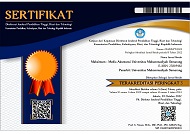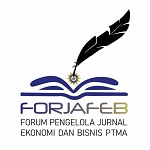The Effect of Environment Performance, Capital Structure, and Company Size on Financial Performance
(1) Universitas Muhammadiyah Semarang
(2) Universitas Muhammadiyah Magelang
(3) Universitas Muhammadiyah Semarang
(*) Corresponding Author
Abstract
One way to assess a company's success is to look at its financial results. Due to the COVID-19 pandemic, the financial performance of the industrial sector plummeted. When a company's financial performance plummets, there is no choice but to declare bankruptcy. Based on data collected from the Indonesia Stock Exchange (IDX) manufacturing business between 2018 and 2021, this study will analyze the relationship between environmental performance, capital structure, company size and financial success. This study uses quantitative methods based on cross-sections of 25 financial statements covering 2018–2021. A combination of descriptive statistics and multiple regression was used in this study. The statistical program SPSS 24 was used for this study. According to research, a company's size, capital structure, and environmental performance all play a role in its financial success. Discussing financial performance is a common theme in many studies. For the latest version of the study, researchers included variables such as capital structure, company size, and period
Keywords
Full Text:
PDFReferences
Achmad, S. L., & Amanah, L. (2014). Pengaruh Investasi,Keputusan Pendanaan,Kebijakan Dividen,Dan Kinerja Keuangan Terhadap Nilai Perusahaan manufaktur yang terdaftar di Bursa Efek Indonesia selama periode 2010-2012. Jurnal Ilmu & Riset Akuntansi, 3(9), 1–15.
Agustin, R., Nurcahyono, N., Sinarasri, A., & Sukesti, F. (2023). Financial Ratio and Stock Returns in Indonesia Equity Markets : A Signaling Theory Approach. International Conference on Business, Accounting, Banking, and Economics, 277–292. https://doi.org/10.2991/978-94-6463-154-8
Akbar, R. R. (2019). Determinan Penerimaan Opini Audit Going Concern Pada Perusahaan Manufaktur. Jurnal Ilmiah Mahasiswa Ekonomi Akuntansi, 4(2), 286–303. https://doi.org/10.33557/mbia.v18i2.353
Anggraeni, A., & Agustiningsih, W. (2023). Pengaruh Kinerja Keuangan dan Ukuran Perusahaan terhadap Nilai Perusahaan dengan Pengungkapan Corporate Sosial Responsibility sebagai Variabel Moderasi. Jurnal Ilmiah Multidisiplin, 2(3), 1015–1024.
Asad, M., Iftikhar, K. I., & Jafary, A. Y. (2019). Relationship between capital structure and financial performance of textile sector companies. Kashmir Economic Review, 28(1).
Bailey, F. . (1989). Intermediate financial management. In The British Accounting Review (Vol. 21, Issue 3). https://doi.org/10.1016/0890-8389(89)90100-5
Chandra, M., & Augustine, Y. (2019). Pengaruh green intellectual capital index dan pengungkapan keberlanjutan terhadap kinerja keuangan dan non keuangan perusahaan dengan transparansi sebagai variabel moderasi. Jurnal Magister Akuntansi Trisakti, 6(1), 45. https://doi.org/10.25105/jmat.v6i1.5066
Christanty, L., Maharani, B., Nugroho, W. S., & Nurcahyono, N. (2023). Accounting Information Systems and Financial Literacy impact on SMEs ’ Performance. MAKSIMUM: Media Akuntansi Universitas Muhammadiyah Semarang, 13(1), 59–69.
Damanik, E. B., Hayat, A., & Sayudi, A. (2022). Pengaruh Penatausahaan Aset dan Pemanfaatan Teknologi Informasi Terhadap Ketepatan Waktu Pelaporan Keuangan: Studi Kabupaten Barito Utara. Maksimum: Media Akuntansi Universitas Muhammadiyah Semarang, 12(1), 1. https://doi.org/10.26714/mki.12.1.2022.1-12
Dianty, A., & Nurrahim, G. (2022). Pengaruh Penerapan Green Accounting dan Kinerja Lingkungan terhadap Kinerja Keuangan. Economics Professional in Action (E-PROFIT), 4(2), 126–135. https://doi.org/10.37278/eprofit.v4i2.529
Dwita, R., & Kurniawan, K. (2019). Pengaruh Struktur Modal, Ukuran Perusahaan dan Keputusan Investasi terhadap Nilai Perusahaan. STATERA: Jurnal Akuntansi Dan Keuangan, 1(1), 76–89. https://doi.org/10.33510/statera.2019.1.1.76-89
Ermawati, D., Nurcahyono, N., Sari, D. N., & Fakhruddin, I. (2023). The Dynamic Impact of Intellectual Capital on Firm Value : Evidence from Indonesia. International Conference on Business, Accounting, Banking, and Economics, 1, 246–262. https://doi.org/10.2991/978-94-6463-154-8
Ernst, B. A., Banks, G. C., Loignon, A. C., Frear, K. A., Williams, C. E., Arciniega, L. M., Gupta, R. K., Kodydek, G., & Subramanian, D. (2021). Virtual charismatic leadership and signaling theory: A prospective meta-analysis in five countries. Leadership Quarterly, May, 101541. https://doi.org/10.1016/j.leaqua.2021.101541
Fajaryani, N. L. G. S., & Suryani, E. (2018). Struktur Modal, Likuiditas, Dan Ukuran Perusahaan Terhadap Kinerja Keuangan Perusahaan. Jurnal Riset Akuntansi Kontemporer, 10(2), 74–79. https://doi.org/10.23969/jrak.v10i2.1370
Fizabaniyah, R., Nurcahyono, N., Argojuwono, A. D. A., & Hernawati, R. I. (2023). Financial Ratio , Board Diversity and Financial Distress : Evidence from Indonesia. International Conference on Business, Accounting, Banking, and Economics, 1, 307–320. https://doi.org/10.2991/978-94-6463-154-8
Gillan, S. L., Koch, A., & Starks, L. T. (2021). Firms and social responsibility: A review of ESG and CSR research in corporate finance. Journal of Corporate Finance, 66(January), 101889. https://doi.org/10.1016/j.jcorpfin.2021.101889
Habibniya, H., Dsouza, S., Rabbani, M. R., Nawaz, N., & Demiraj, R. (2022). Impact of Capital Structure on Profitability: Panel Data Evidence of the Telecom Industry in the United States. Risks, 10(8), 1–19. https://doi.org/10.3390/risks10080157
Hadi, N., Sheila, S., Firmansyah, A., & Trisnawati, E. (2021). Respon pasar atas pengungkapan keberlanjutan pada perusahan perbankan di indonesia: peran ukuran perusahaan. Bina Ekonomi, 25(2), 97–111. https://doi.org/10.26593/be.v25i2.5339.97-111
Hartanto, M. C., Prajanto, A., & Nurcahyono, N. (2023). Determinants of going-concern audit opinions : Empirical evidence from listed mining firms in Indonesia. Maksimum: Media Akuntansi Universitas Muhammadiyah Semarang, 13(1), 17–27. https://doi.org/10.26714/mki.13.1.2023.17-27
Ifada, L. M., Ghoniyah, N., & Nurcahyono, N. (2023). How Do Tax Avoidance and Profitability Influence a Firm’S Intrinsic Value? Jurnal Akuntansi Multiparadigma, 14(1), 115–125. https://doi.org/10.21776/ub.jamal.2023.14.1.08
Josephine, K., Trisnawati, E., & Setijaningsih, H. T. (2019). Pengaruh Modal Intelektual Dan Tata Kelola Perusahaan Terhadap Nilai Perusahaan Melalui Kinerja Keuangan (Studi Empiris Pada Perusahaan Lq45 Di Bursa Efek Indonesia Periode 2015-2017). Jurnal Muara Ilmu Ekonomi Dan Bisnis, 3(1), 59. https://doi.org/10.24912/jmieb.v3i1.2474
Karnoto, S. Bin, Almasyhari, A. K., & Budiarto, D. S. (2023). Declining financial performance of local governments in Indonesia : An empirical study during Covid-19. Maksimum: Media Akuntansi Universitas Muhammadiyah Semarang, 13(1), 70–84.
Kartika, N., & Iramani, R. (2013). Pengaruh Overconfidence, Experience, Emotion Terhadap Risk Perception Dan Risk Attitude Pada Investor Pasar Modal Di Surabaya. Journal of Business and Banking, 3(2), 177. https://doi.org/10.14414/jbb.v3i2.235
Khairiyani, K., Mubyarto, N., Mutia, A., Zahara, A. E., & Habibah, G. W. I. A. (2019). Kinerja Lingkungan Terhadap Kinerja Keuangan Serta Implikasinya Terhadap Nilai Perusahaan. ILTIZAM Journal of Shariah Economic Research, 3(1), 41. https://doi.org/10.30631/iltizam.v3i1.248
Kristianingrum, A., Sukesti, F., & Nurcahyono, N. (2022). Pengaruh Mekanisme Good Corporate Governance, Kinerja Keuangan, dan Struktur Modal terhadap Pengungkapan Sustainability Report. Prosiding Seminar Nasional UNIMUS, 5, 432–444.
Li, S., Shi, W., Wang, J., & Zhou, H. (2021). A Deep Learning-Based Approach to Constructing a Domain Sentiment Lexicon: a Case Study in Financial Distress Prediction. Information Processing and Management, 58(5), 102673. https://doi.org/10.1016/j.ipm.2021.102673
Meiyana, A., & Aisyah, M. N. (2019). PENGARUH KINERJA LINGKUNGAN, BIAYA LINGKUNGAN, DAN UKURAN PERUSAHAAN TERHADAP KINERJA KEUANGAN DENGAN CORPORATE SOCIAL RESPONSIBILITY SEBAGAI VARIABEL INTERVENING (Studi Empiris Pada Perusahaan Manufaktur yang Terdaftar di Bursa Efek Indonesia Tahun 2014-. Nominal: Barometer Riset Akuntansi Dan Manajemen, 8(1), 1–18.
Mohd Sofian, F. N. R., & Muhamad, R. (2020). Modified integrated Islamic CSRD index and financial performance of Malaysian Islamic banks: Stakeholders’ perception. Journal of Islamic Accounting and Business Research, 11(8), 1599–1617. https://doi.org/10.1108/JIABR-10-2018-0158
Mujiyati, Ariani, K. R., & Pratama, H. N. (2021). The Effect of Corporate Governance Mechanism and Company Size on Financial Distress. Maksimum: Media Akuntansi Universitas Muhammadiyah Semarang, 11(2), 67. https://doi.org/10.26714/mki.11.2.2021.67-74
Nahdhiyah, A. I., & Alliyah, S. (2023). The Effect Of Profitability , Liquidity , Leverage , Company Size and Assets Growth on Stock Return : Empirical evidence from Indonesia. Maksimum: Media Akuntansi Universitas Muhammadiyah Semarang, 13(1), 50–58.
Nawaz, T., & Ohlrogge, O. (2022). Clarifying the impact of corporate governance and intellectual capital on financial performance: A longitudinal study of Deutsche Bank (1957–2019). International Journal of Finance and Economics, August 2020, 1–16. https://doi.org/10.1002/ijfe.2620
Ningsih, R. D., & Ariani, N. E. (2016). Pengaruh Asimetri Informasi, Pengungkapan Modal Intelektual, dan Kualitas Audit Terhadap Biaya Modal Ekuitas. Jurnal Ilmiah Mahasiswa Ekonomi Akuntansi, 1(1), 149–157. https://doi.org/10.30595/ratio.v4i1.15879
Nur Amalia, A. (2021). Pengaruh Ukuran Perusahaan, Leverage Dan Struktur Modal Terhadap Kinerja Keuangan. Jurnal Ilmu Dan Riset Manajemen, 10(5), 1–17.
Nurcahyono, N., Hanum, A. N., Kristiana, I., & Pamungkas, I. D. (2021). Predicting fraudulent financial statement risk: The testing dechow f-score financial sector company inindonesia. Universal Journal of Accounting and Finance, 9(6), 1487–1494. https://doi.org/10.13189/ujaf.2021.090625
Pelaez-Verdet, A., & Loscertales-Sanchez, P. (2021). Key ratios for long-term prediction of hotel financial distress and corporate default: Survival analysis for an economic stagnation. Sustainability (Switzerland), 13(3), 1–17. https://doi.org/10.3390/su13031473
Pindado, J., Rodrigues, L., & de la Torre, C. (2008). Estimating financial distress likelihood. Journal of Business Research, 61(9), 995–1003. https://doi.org/10.1016/j.jbusres.2007.10.006
Pratiwi, I., Hanum, A. N., & Nurcahyono, N. (2022). Pengaruh Earning Per Share, Total Assets Turnover, Pertumbuhan Penjualan dan Debt Equity Ratio Terhadap Harga Saham. Jurnal Akuntansi, Perpajakan Dan Portofolio, 02(02), 39–50. https://journal.umpo.ac.id/index.php/JAPP/article/view/5584%0Ahttps://journal.umpo.ac.id/index.php/JAPP/article/download/5584/2405
Prena, G. Das. (2021). Pengaruh Penerapan Green Accounting Dan Kinerja Lingkungan Terhadap Kinerja Keuangan Pada Perusahaan Manufaktur Di Bursa Efek Indonesia. Jurnal Akun Nabelo: Jurnal Akuntansi Netral, Akuntabel, Objektif, 3(2), 495–507.
Qureshi, M. A., Kirkerud, S., Theresa, K., & Ahsan, T. (2020). The impact of sustainability (environmental, social, and governance) disclosure and board diversity on firm value: The moderating role of industry sensitivity. Business Strategy and the Environment, 29(3), 1199–1214. https://doi.org/10.1002/bse.2427
Raflis, R., & Arita, E. (2021). Impak Struktur Modal, Struktur Kepemilikkan dan Karakteristik Perusahaan Terhadap Financial Distress dan Financial Health Perusahaan. Jurnal Ekonomi Dan Bisnis Dharma Andalas, 23(1), 135–149. https://doi.org/10.47233/jebd.v23i1.199
Rhamanti, V. N. (2012). Sebuah Kajian Mengapa Akuntansi Syariah Masih Sulit Tubuh Subur di Indonesia. Jurnal Akuntansi & Investasi, 13(2), 161–179.
Ritonga, S. A., Effendi, I., & Prayudi, A. (2021). Jurnal Ilmiah Manajemen dan Bisnis ( JIMBI ) Pengaruh Struktur Modal Terhadap Kinerja Keuangan Perusahaan Consumer Goods di BEI The Effect of Capital Structure on the Financial Performance of Consumer Goods Companies on the BEI. Jurnal Ilmiah Manajemen Dan Bisnis, 2(2), 86–95. https://doi.org/10.31289/jimbi.v2i1.383
Ruwanti, G., Chandrarin, G., & Assih, P. (2019). Corporate social responsibility and earnings management: The role of corporate governance. Humanities and Social Sciences Reviews, 7(5), 1338–1347. https://doi.org/10.18510/hssr.2019.75172
Scott, D. W. (2015). Multivariate density estimation: theory, practice, and visualization. John Wiley & Sons.
Sihono, A., & Khairiyahtussolihah, A. (2022). Does tax aggressiveness and cost of debt affect firm performance? The moderating role of political connections. Maksimum: Media Akuntansi Universitas Muhammadiyah Semarang, 10(1), 39–49. https://doi.org/10.1080/23322039.2022.2132645
Spense, M. (1973). Job Market Signaling. The Quarterly Journal of Economic, 87(3), 355-374.
Sudana, I. 2017. (2017). Manajemen Keuangan Perusahaan Teori dan Praktek.
Sugara, K., Wijaya, T., & Keristin, U. W. (2022). Pengaruh kepemilikan publik, struktur modal, dan ukuran perusahaan terhadap manajemen laba pada perusahaan manufaktur yang terdaftar di bursa efek Indonesia tahun 2018-2020. Jurnal Keuangan Dan Perbankan, 19(1), 15–26.
Susilawati, D., Wardana, L. K., & Rahmawati, I. F. (2018). Menilai kinerja keuangan dengan analisis rasio keuangan: Studi kasus BKAD Sleman. Jati: Jurnal Akuntansi Terapan Indonesia, 1(2), 91–98. https://doi.org/10.18196/jati.010210
Susilowati, Y., Widyawati, R., & Nuraini. (2018). Pengaruh Ukuran Perusahaan, Leverage, Profitabilitas, Capital Intensity Ratio dan Komisaris Independen Terhadap Effective Tax Rate. Prosiding SENDI_U 2018, 2014, 796–804.
Tambunan, J. T. A. dan B. P. (2018). Pengaruh ukuran perusahaan, leverage dan struktur modal terhadap kinerja keuangan perusahaan (studi pada perusahaan manufaktur sektor aneka industri tahun 2012-2016). Diponegoro Journal of Social and Politic, 7, 1–10.
Timoty, N. F. M., Nurcahyono, N., Yasaputri, K., & Jatiningsih, D. E. S. (2022). Predicting the risk of financial distress using corporate governance measures. International Conference on Business, Accounting, Banking, and Economics, 68, 228–245. https://doi.org/10.1016/j.pacfin.2020.101334
Tinoco, M. H., & Wilson, N. (2013). Financial distress and bankruptcy prediction among listed companies using accounting, market and macroeconomic variables. International Review of Financial Analysis, 30, 394–419. https://doi.org/10.1016/j.irfa.2013.02.013
Videsia, Y., Wibowo, R. E., & Nurcahyono, N. (2022). Pengaruh Profitabilitas Dan Ukuran Perusahaan Terhadap Ketepatan Waktu Pelaporan Keuangan. Review of Applied Accounting Research, 9(2), 219–228. https://doi.org/10.32534/jpk.v9i2.2407
Yuliani, E. (2021). Pengaruh Struktur Modal, Likuiditas dan Pertumbuhan Penjualan Terhadap Kinerja Keuangan. Jurnal Ilmu Manajemen, 10(2), 111. https://doi.org/10.32502/jimn.v10i2.3108
Article Metrics
Abstract view : 107 timesPDF - 0 times
DOI: https://doi.org/10.26714/mki.12.2.2022.175-184
Refbacks
- There are currently no refbacks.
-----------------------------------------------------------------------------------------------------------------------------------------------------------------------------------
 | MAKSIMUM: Media Akuntansi Universitas Muhammadiyah Semarang |
![]()
Maksimum: Media Akuntansi Universitas Muhammadiyah Semarang is licensed under a Creative Commons Attribution Attribution-NonCommercial-NoDerivatives 4.0 International License.

















